
Scattered thunderstorms this afternoon could produce localized strong wind gusts and hail. The main threat is between 3 PM and 10 PM. A widespread freeze is likely on Wednesday night. Read More >
The Palm Sunday Tornado Outbreak of 1965 in West Michigan
The spring of 1965 was cold and stormy. Three feet of snow fell in March at Grand Rapids, making it the snowiest on record. The temperature hit zero degrees on March 27th and ten degrees on April 3rd. This cold and snowy pattern in March is similar to other years that saw big April tornado outbreaks in Michigan. In 1956, 1967 and 1974, very cold weather prevailed into April, followed by a sudden warming. Then the tornadoes came through, soon followed by more cold weather. The brief warming that preceded the tornadoes was the result of strong southerly winds in advance of a strong low pressure center. The weather maps of April 10th and 11th 1965 show a low tracking from the Central Plains into southern Lower Michigan. In the “warm sector” ahead of the low, the temperature rose to 72 degrees at Grand Rapids that Sunday afternoon.
A line of powerful thunderstorms formed over Iowa during the afternoon then moved into Wisconsin and Illinois. The Severe Local Storm Warning Center of the U.S. Weather Bureau issued a tornado forecast at 1 pm for northern Illinois and parts of adjacent Iowa and Wisconsin. The term “watch” would be used instead of “forecast” for severe weather outlooks after this historic event. Several of the thunderstorms spawned tornadoes, including one that killed three people in southern Wisconsin.

A map of the tracks of the tornadoes that struck on April 11-12, 1965.
The storms continued east, crossed Lake Michigan and moved from Illinois into Indiana. By 6 pm, two more tornado forecasts were issued, covering the northern half of Indiana and Ohio and the southern half of Lower Michigan. The Michigan forecast offices, including Grand Rapids, were aware of the destruction that had already occurred further west, and began issuing weather bulletins describing the progress of the thunderstorms they were watching on radar:

There was no mention of tornadoes in this statement. At the time, the Weather Bureau thought the word “tornado” would cause panic and did not issue a warning until tornadoes were confirmed. The squall line began to intensify as it moved east and word was received that the storms had brought tornadoes to Illinois. The next statement from Grand Rapids at 615 PM expressed how the threat had evolved.

The storms along the squall line moved east and brought tornadoes to Kalamazoo, Allegan and Ottawa Counties. One tornado moved northeast of Kalamazoo and injured 17 people. In Allegan County a tornado killed one person in Burnips. A severe storm intensified as it moved towards Allendale, where a tornado began its 35 mile rampage. It tracked south of Marne then inflicted heavy damage to Alpine Township, Comstock Park, and Rockford before ending near Cedar Springs. Five people were killed and over 100 injured. One of the injured would die days later, raising the death toll to six. Another tornado, probably from the same storm, hit Montcalm and Gratiot Counties, heavily damaging several farms. The Grand Rapids Weather Bureau issued this somber statement after the storms had moved out of West Michigan:

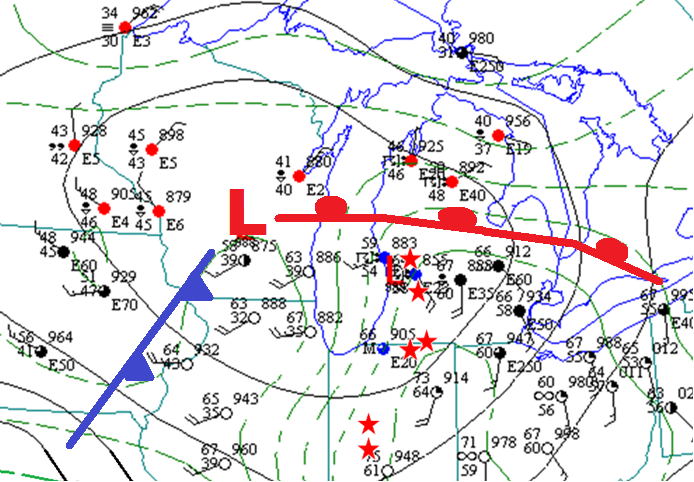
The weather map at 7 PM on April 11, 1965 shows the low pressure center over Wisconsin and a warm front north of Grand Rapids. The red stars show the locations of tornadoes.
Even worse destruction and loss of life was concentrated further south, where two powerful tornadoes tracked from the Indiana border across Branch County all the way to Washtenaw County, within a mile or so of each other and less than an hour apart. A total of 44 people were killed along the 80 mile path and it was difficult to tell which tornado did what damage or claimed which victims. People that had been hit by the first tornado had to take cover to avoid the second.
After these two tornadoes ended the focus shifted to Ohio, where the northern suburbs of Toledo were visited by a powerful tornado that destroyed entire blocks with many houses levelled to the ground. Vehicles were tossed through the air, including a bus that was lifted and dropped upside down by the tornado, killing five people. The total death toll was 18 for the tornado. As bad as that storm was, communities further south in Ohio saw even worse. A series of deadly tornadoes struck one after another from Lima in western Ohio to Strongsville, southwest of Cleveland, killing more than 40 people. After midnight, when it was finally over, nearly 50 tornadoes had killed more than 250 people in six states. All that was left was a cold wind blowing through areas of devastation filled with shattered lives, farms, businesses and neighborhoods.
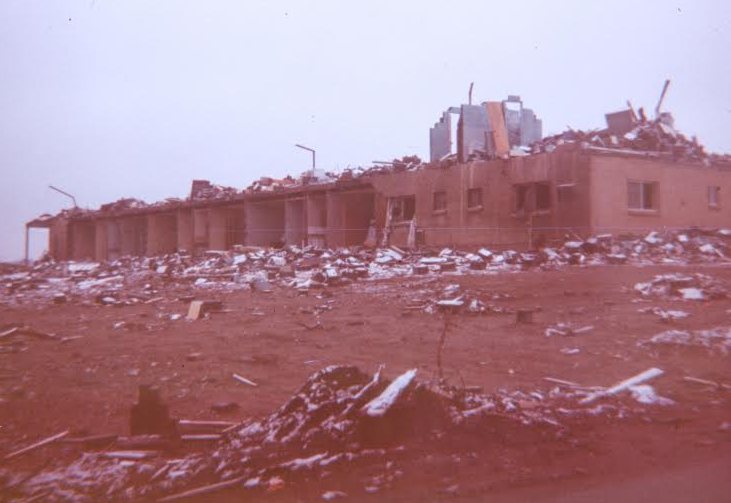
Swan Inn Demolished.The building was at the intersection of Alpine Avenue and 6 Mile Road. One of the guests was fatally injured. Photo credit: Walter L. Nelson.
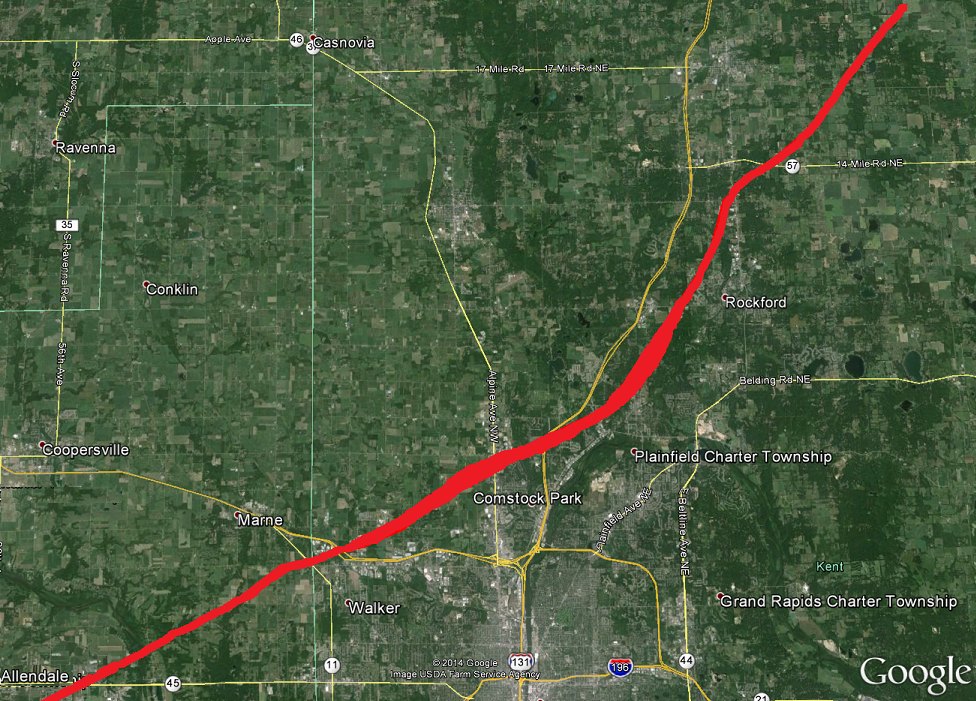
The Allendale to Cedar Springs Tornado. The 35 mile-long damage path curved to the north of Comstock Park and followed the path of the April 3, 1956 tornado to the west side of Rockford.
Stories of the Palm Sunday Tornadoes
Account of Jackie Brewer
April 11, 1965 started out to be a beautiful day. My family spent most of the day outside. Later my husband was relaxing on the living room couch and the children and I were in the kitchen making caramel apples. Since I was busy directing four small children (ages 2 through 7), with the apples I didn’t notice any early signs of a storm. Suddenly, it was very dark outside and there was a terrible noise! At that moment, it woke my husband and he ran to the kitchen, yelling for me to get to the basement. With a two year old in my arms and, holding the hand of another, I headed for the well pit of the basement. My husband was behind me, holding the other two. We didn’t really know at this point what was happening, only that it was something bad and we had to get to the well pit.
We barely got into the basement when the house rose up off its foundation. I froze! I can still see the gap between the house and the ground. I held my mouth so tight I chipped my front tooth. My husband kept calling my name over and over, pushing me towards the well pit. It was only seconds from the kitchen to the well pit and we realized later that we were in the middle of the tornado at that time.
It rained very hard and the sky was an ugly yellow. The six of us huddled in the well pit, soaking wet. I kept wondering if it would come back. My husband, who had saved our lives with his quick actions, suddenly felt faint. I kept telling him that we needed him and he couldn’t pass out. We sat in the well pit for about 20 minutes until a neighbor appeared. It was a man I never met formally, but I was never so glad to see anyone in my life, because it meant that it was safe to get out and move about.
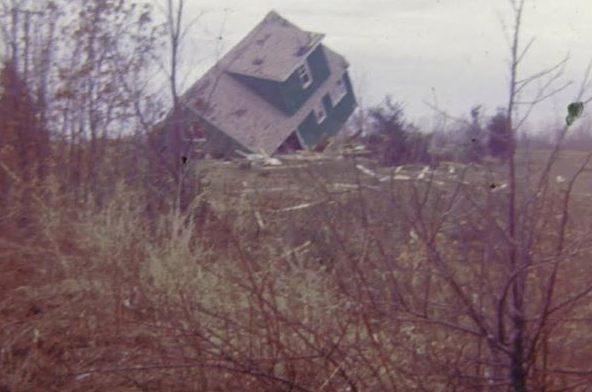
The Brewer home on Samrick Avenue after the tornado. Photo courtesy of Lee Nelson.
Account of Earlene Baum
My father, Earl McMullin, lived in a house on Algonquin Lake near Hastings, Michigan. On the evening of April 11, 1965 a tornado struck Barry County, passing northwest of Hastings. My father went to the basement and when he came back upstairs and looked outside noticed lots of debris floating in the lake. He also saw that one of the neighbor’s house was completely destroyed. My father passed away in 2011 at the age of 95, still living in the same house.
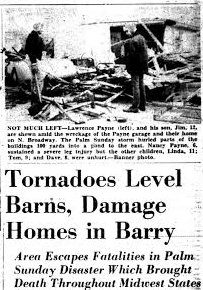
Headlines in the Hastings Banner describing the tornado that struck Barry County. Courtesy of Earline Baum and the Hastings Public Library.
Account of Tom Cubberly
I was born and raised in Tecumseh, MI, and, like many, the coming of spring was very welcome. I was 15 and loved to volunteer time at Meyers airport, one mile North of Tecumseh, doing odd jobs in exchange for flying lessons. But as I stood on the ladder putting 80 octane gas into Lou Shroeder’s Cessna 172 for the sky-divers, I sensed it odd that this Sunday morning was so warm. I was facing the plowed corn field to the South and the hazy sky seemed even more washed out than is normal for April. It seemed the sun was back-lighting the atmosphere with an inversion of eerie-ness. There was much to do that day. The sky divers, most from the Detroit area with Harold Lange as owner of the club, were taking advantage of the good early spring flying weather. This was their third year of jumping at Meyers field and they were anxious to get a few in today. After gassing their plane, I noticed Al Meyers and Nadia pull into our gravel parking lot. By the little bags they were carrying, it looked like they were planning a trip in their Cessna on this day.
I walked over to them and, as was his customary greeting, Al said, “Tommy, how’s Tommy today?” I answered “fine” and asked if he wanted the 182 (his 1956 Cessna) out and topped. He affirmed that so I got busy pushing those huge steel hanger doors open to expose sunlight on the Eastern-facing birds. After inserting the red painted pull bar into the nose wheel, I pulled as Al pushed on a wing strut until the plane was on the tarmac, turning it so the prop wash would not blast the hangar at engine start. Al and Nadia climbed in and soon I heard Al holler, “Clear prop!” I stood back a little further. The 230 hp. Continental coughed to life. They taxied away and, as the wind sock was limp from lack of wind, Al elected to warm up and take off from the South end of the 2600 foot strip. I waved goodbye as the blue and green over white bird lifted off in her factory paint scheme, never brighter as I had just washed her the day before. Wiping oil off airplane bottoms was one of my jobs between complete washings. Pilots told me it really made a difference in air-speed. They gained five mph with a clean belly vs. having oil and grease from cowl to rudder
I watched the Cessna until it was out of sight, heading southwest. Indiana was their destination, perhaps Garrett, a town to which they had taken me in the same airplane the year before. Nadia was in the pilot’s seat at the time as she was learning to fly herself. The hangar doors closed with a thud and seemed easier this time as my muscles were warmed up. It was time for lunch. I was thankful the bowling alley across the street had a small diner. It seemed no time but the droning of Al’s plane was easily distinguished from the chatter of the sparrows and pigeons in the rafters of the hangars. It was about five o’clock when I caught sight of Al and Nadia entering the down-wind leg of the pattern. They turned easily onto base and then final at four hundred feet, flaps extended forty degrees as the wind was light. There was no cross wind so I expected them to “grease it on” which they did. That plane was a work horse and I knew it could take a bouncy landing but that was not in the offing. The parallel grass strip to 36/18 (our paved runway) aided many pilots by cushioning the touch down and also saved rubber on the tires. But Al elected to use the pavement, then taxied toward me and the hanger.
That grass strip as well as the East-West strip kept me busy for years mowing and filling holes made by ground hogs, fox and any number of night animals. While mowing with the old Ford 9N tractor with Cadet cutter, I would frequently dismount, shovel in hand, to fill in holes large enough to cause a nose wheel serious trouble if hit. There was also a seldom used OTW Southwest/Northeast grass strip. Al Meyers and his aircraft company made WW2 bi-plane trainers for the war, appropriately named OTW, or Out To Win! A short strip, as this one, was plenty for these nimble birds with a moderate, prevailing Southwest wind.
“Don’t bother to gas her, Tommy,” Al said as he and Nadia climbed out of the cockpit. “We’ve got to get her inside and as many as we can. Weather coming! The Flight Service Station out of Fort Wayne issued a NOTAM on an approaching severe storm from the area we came from.” Indeed, Detroit radar showed thunderstorms increasing rapidly over Northern Indiana by late afternoon. Al looked around then said, “I feel there is going to be a significant storm, we need to secure all the planes possible.” I was concerned as the sky was darkening early in the south. I was also concerned about fitting the planes into the hangar. It was a cement block building, very solid and could afford much safety, but it never looked smaller now. Carefully pushing the Cessna in, we then jig-sawed another fabric tail-dragger inside, nosed into the sliding door.
We had one more plane that was parked on the tarmac but could not fit her into the confines of the hangar. It was a blue Meyers 200 (which Al was later to own) that would have to stay outside. Nosing her close to the hangar, facing west, we fastened lines to her under-wing hooks and tied her to the huge steel doors. We chocked her wheels the best we could. This was all we could do for an overnight outsider if weather was expected but I said an extra prayer for that plane and several others that were always parked outside, tied down on the grass. I was feeling nervous. The air seemed weird. The sky was a funny yellow-green. I did not like it.
As I could not drive yet, I pedaled my bike home the mile on Tecumseh-Clinton Road. As I pulled into our drive on Shawnee street next to the High School it got dark. I entered the back door by the old garage and could smell tomato soup warming on the stove. Mom had some baloney sandwiches ready for me too. Dad was home but my sister Donna was at church. Brother Jim was not home, out driving someplace in his black 1960 Chevy, probably to a girlfriend.
As I sat down to eat about 7:30 the wind came up. Then the large maples out front, with only buds and catkins on the limbs, started swaying and moaning with the added sound of splattering rain. My first bites of the sandwiches were merely nibbles. The soup would not go down except a few slurps. I was nervous, as an aspiring pilot, along with seasoned ones, have an aversion to storms. Perhaps I could sense the low barometer. Something made my skin crawl. I thanked Mom for the soup but could not finish it. The sirens had now started to wail. We were in for a blow!
My sister Donna came home from church and said limbs already were coming down. We were concerned about our brother Jim being out there… somewhere. My oldest brother, Bob, and his wife Kay and daughter Carolyn were safe in their apartment in our house. Safe as we could be as lightning flashed and the thunder cracked sharply, announcing its nearness. We sat it out, listening to the unending wailing sirens, then the fire and police horns adding to the tension. What I heard under the frequency of the sirens was like a low pulsating swooshing sound. People say a tornado sounds like an old steam engine train chugging. I will not dispute that. That noise bothered me the most, as it seemed to increasingly get closer to 303 East Shawnee Street.
Then, it seemed to end. Near 8 PM, dark now and quieter. Relief filled the living room where we tried to get a Detroit TV station for any information. But relaxing was short as noise rumbled and roared, worse this time, like that freight train had taken a siding and was heading for us again! The path of this second storm was just west of us no more than half a mile. It was evident to us we were in for a second blow. This one below the belt. The sirens screamed again.
We rode it out, thankful it was not a direct hit, but aware someone was getting it, and plenty of it. As things died down this second time I looked outside to the north. The emergency vehicles seemed to be heading mostly north. Of course, that was the direction of the airport! Now, as I looked out, an eerie red glow emanated from the direction of the airport, flickering as if a fire were beyond the trees about a mile. I had to look over the High School, but that did not obstruct my view of clouds painted red and angry looking. About then, Jim came home, shaking.
Not given to emotion normally, Jim was indeed shaken and told his story of the tornado he witnessed. He said he was just South of Tipton when one of the tornadoes hit. (Tipton took a direct hit.) From inside his car he said it looked like a wall of water. Then the car was sashayed about, its nose swaying briskly left and right. He abandoned the car and tried walking to shelter when the wind nearly picked him up, scooting him where he did not want to go. Somehow he made it back to the car and stayed put. He drove home, dodging the many tree limbs and debris on the roads. Power was out along the way, although we never lost power.
The sirens subsided. So did the red glow in the North sky. We went to bed and as I lay there looking out my South window, the moon was shining. The sky parted with only puffy, friendly looking clouds. While wet looking, with limbs scattered, the night looked like it had experienced nothing more than a spring shower.
Monday arose with overcast skies and the talk in school was all about the tornadoes. One classroom had west-facing walls and as I looked out the windows the clouds were in rows of rolls, gray and unfriendly. I endured school that Monday but was eager to get out to the airport to see what happened there. I was tense and imagined the worst. My planes, my hangars… how were they? Nobody all day talked about that. I had to know. And what was that fiery red glow in the sky last night that surely meant the demise of a hangar?
I dropped my school books off and jumped on my Schwinn bike as quickly as I could that afternoon. Homework would have to wait. I pedaled hard, detouring around much debris on the roadside as garbage, roof shingles and limbs impeded my travel. When I got as far as John Smith’s house just before Cunningham’s Airport Bowl bowling alley I could see my worst fears were unfounded. The hangars withstood the blow, though nearly at ground-central, of the storms.
Lightning had indeed struck a barn on the east perimeter of the airport, kitty-corner from Al Meyer’s house. That answered my question of the mysterious red glow. But the “hangar” near it was damaged. It held no planes at the time. It was used as storage by Otto Meyers of the boat division of Meyers Aircraft Company. They built not only aluminum boats, but Jeep tops and motorcycle side cars as well. This small building served as a warehouse of sorts. But planes tied down nearby did not fare so well. An Aeronca Champ, the flying club had bought and rebuilt, sustained fuselage damage as a wing tie down failed and the tail was mightily twisted to one side by the tornadoes. The guys had just given it the nicest blue over white paint job on its all-fabric surface. I had helped do it. We used Seconite, a new fabric, gaining favor at the time.
A Piper Tri Pacer seemed to survive OK as well as a Navion and Frank Bisher’s WW2 PT-26 trainer (in which Frank had given me my first airplane ride two years before.) These planes were tied down and were either transients or locals who rented the grassy spots with tie-down hooks firmly cemented in the ground by the FBO (Fixed Based Operator, in this case, Meyers Airport.) The planes were exposed to the elements but securely tied down for most weather conditions. Men were on the southwest roof corner of the factory hangar making repairs already as I surveyed the situation. This was the welding area where Gracey and Omer, Roy and Elmer fabricated the Meyers 200’s airframe and stub-wing assemblies. Our large oak tree nearby survived as well as our beacon light. But the roof damage was not the end of it and indeed caused trouble elsewhere, far from the welding department.
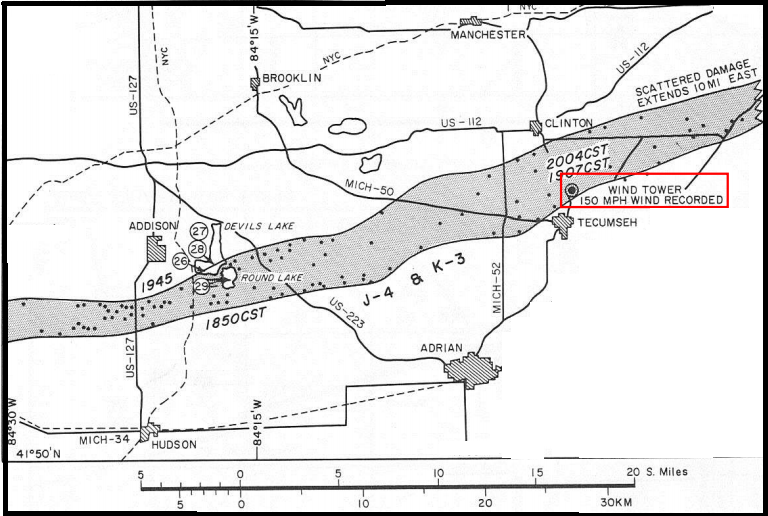
Map of the combined damage of two tornadoes across southeast Lower Michigan, from the seminal research by Professor Ted Fujita, showing the areas affected by the two tornadoes and the location of a 151 mph wind gust. Courtesy of Dr. Kazuya Fujita.
The tornadoes, coming from the southwest, blew roofing materials and shingles like bullets toward the parked planes by the ramp past the gas pumps. Several planes parked there on the west side of the runway, backing up to the Boat Division buildings, sustained varying degrees of flying missile damage but the tie downs held. Of most concern to me and the five owners was the fate of one red and white Piper. We called her the “Old Girl.” She was a 1947 Piper Super Cruiser. A tandem, yet 3 passenger (very cozy) plane, she was of stick and tail-dragger design, common to that time. N2444M was her “N” number but it was hard to read those large numbers on her fuselage now. Tar paper had punched many holes in her right side, tail and wings. This was the plane I flew, taking lessons from CFI Bill Davenport but it would be a while before another lesson. The Meyers 200 we could not get into the hangar Sunday night had moved some despite the wheel chocks and the brakes being set but was otherwise unharmed. A new, unpainted Meyers 200 in the factory hangar next door was pushed, damaging the propeller spinner. It was parked very near the door facing it when the suction of the tornado bowed the door into the spinner. That was enough to push the plane back a foot or two where the trailing edge of the left semi-fowler flap on its wing snagged the propeller of the plane behind, causing buckling damage to the flap. As I mentioned earlier, parking planes in a hangar is like a jig saw puzzle and close tolerance is the rule. It is an unforgiving environment and mistakes are costly. Storms are something for which we have no extra room.
Ray Betzoldt had room for me though! He said, “Get in, Tom, (he called me Tom, not Tommy, but then he had 5 sons, Al had no children) we are going to fly over the tornado’s path.” Ray’s second-youngest, Fred, jumped into the co-pilot’s seat of the Cessna 182 and I took a back seat. Soon we were in the air. Still overcast skies prevailed, but the ceiling was high enough to be of no concern. I never had concerns with Ray at the controls as he was Meyer’s test pilot with much experience with land and sea planes. We flew southwest toward Tipton and beyond to Devil’s Lake which took direct hits. Lives were lost here and it showed from the air. Houses and cottages seemed to have imploded due to the ferocity of the storms. Thankfully it was April and many summer cottages were not yet occupied. We turned around and had no trouble following the debris trail northeast all the way to Ann Arbor where it lessened in visual acuity. It was like following a railroad track about a quarter mile wide with house and barn contents all along the way. Clothes, papers, insulation, broken timber and boards, cars overturned made the trail of destruction highly visible. When we flew over the woods, twisted trees carved their own impassable log jams in their wake.
As the news unfolded that week, we learned that at least 14 people were killed in Lenawee County alone with 189 homes destroyed. These tornadoes ranked an F4 on the Fujita scale with paths as long as 90 miles. A final killer tornado hit near the Michigan/Ohio border North of Toledo at about 9:30. That is an hour and a half after the twins that hit us. We landed back at Meyers airport and went to work cleaning up and making repairs as best we could. Summer would be here soon and in two months I would solo in that Supercruiser, by then patched up and airworthy once again. I went on and got my pilots license and took others up as Al and Ray had me, a young boy hooked on hangar life and flying after that first ride in 1963.
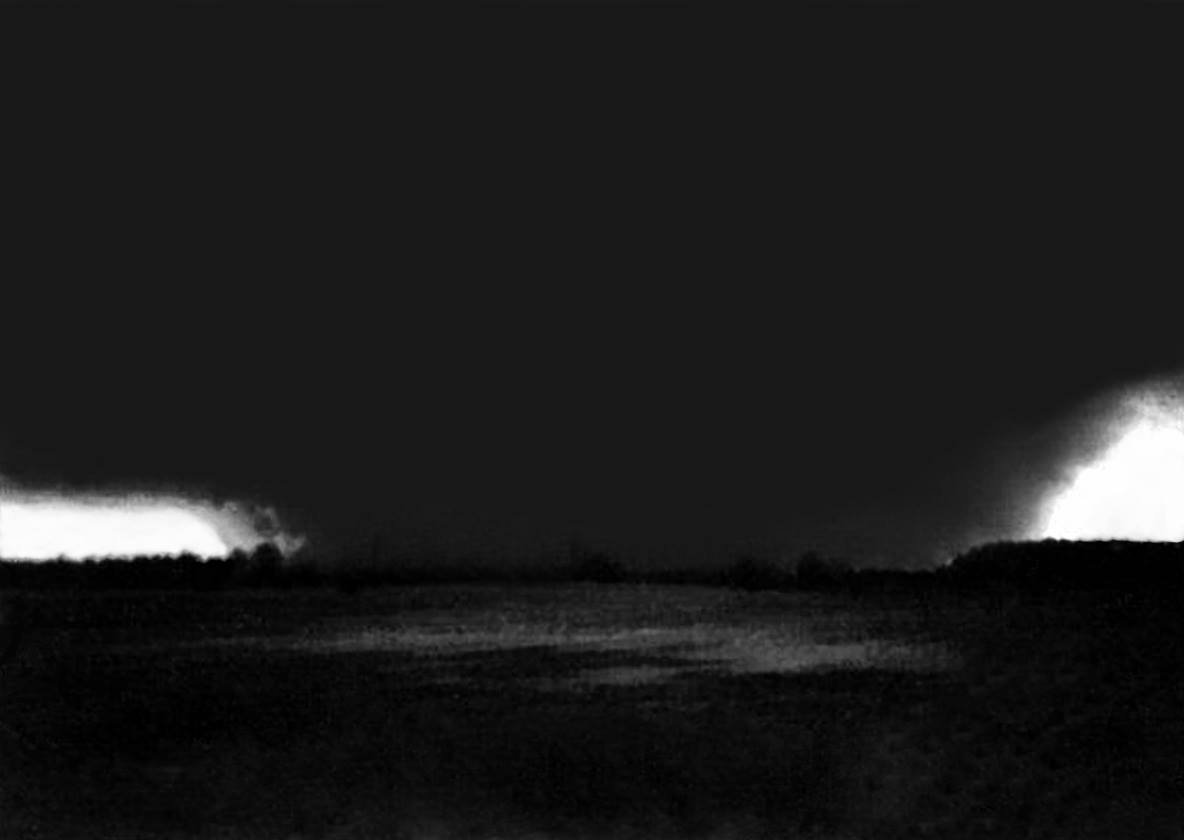
One of the two large tornadoes that tracked through eastern Branch County, Michigan. Photo credit Dale Myers, courtesy of Ron Wilbanks.
Account of Larry Handy
I have a special recollection of April 11, 1965. Our first daughter was born in the morning. The hospital had all visitors leave early that afternoon and we didn’t know why. Of course, later we found out it was because they were preparing for the storms and expected the possibility of an influx of injured patients, which did indeed happen that evening. The next day we found out that one of the new mothers at the hospital did not have a home to go to; the tornado had destroyed it. That made the point to us that it was a very sad time for a lot of people. We considered ourselves very lucky. At times over the years we tease our daughter that she brought the tornado to Grand Rapids.
Account of Doug Houseman
My father was a state police officer stationed in White Pigeon during the tornadoes. I ended up riding with him (I was in 5th grade) when he was detailed to drive to Shipshewana, Indiana right after dawn on April 12th. I have vivid memories, from that drive – of the barn that was thrown in the swamp – with the live cows standing in the stanchions where the barn had been to the car wrapped around the tree 25 feet in the air – and the passenger compartment less than a foot across and the rear bumper of the car 390 degrees or so from the front bumper. The most amazing sight was the road that had been blacktopped on April 9th – more than a ½-mile of the black top was rolled up like a huge jelly roll.
I don’t know how many of the pictures from that area survive, but the library in White Pigeon got copies of all the pictures my father took that day on the trip down and back. It took several hours to go down and back, stopping to check on people as we went. Other officers were responsible for checking the rest of the area along US-12 and other roads in the area.
When we got home, I found a broom (intact) and a Raggedy Ann type doll on the roof of our house, and several full boxes of food in our back yard. I never did find out where they came from, but it had to have been several miles away. A couple of weeks later I watched my first Amish barn raising at the site of the cows – that was to me as impressive as the damage the storm did.
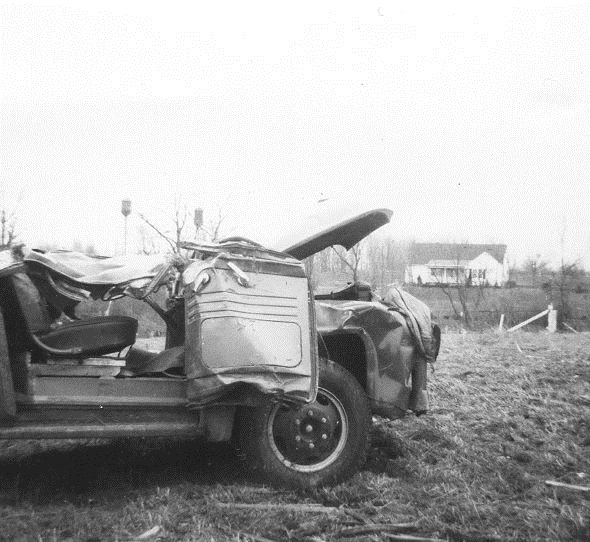
The doors on this car were folded back as it was rolled by the tornado. Photo courtesy of Stephen Pitsch Sr.
Account of Marilyn McLenithan
Palm Sunday 1965 was a day I will never forget. My family was coming back from my parents in White Cloud, when we saw the tornado coming at us as we approached the intersection of Alpine Avenue and Six Mile Road. It came up very fast, and it didn’t even look like rain until it appeared. I cannot say if there was a roaring sound, as I was busy pushing my three girls and the dog to the floor of the car, hoping that would protect them. When the tornado hit, it was twirling all the power lines around and it left them down all around us. We were in front of the Swan Inn. My husband went to help the injured and people trapped in the buildings, while I, along with my three daughters, found a young girl and boy and took them back to their house. The girl just keep saying, “I could not hold her, could not hold her”. From what I could tell, she had lost her younger sister in the tornado. I never did find out the name of the family. I would love to know their name and find out what happened to the young girl. We did not know where my husband was for some time. None of us were injured, but did see a man hanging upside down from a tree.
The back of the Swan Inn was completely gone. Some of the people there had taken shelter in the bathroom, which saved them. My husband found and returned someone’s purse, which was sitting on the floor, untouched.
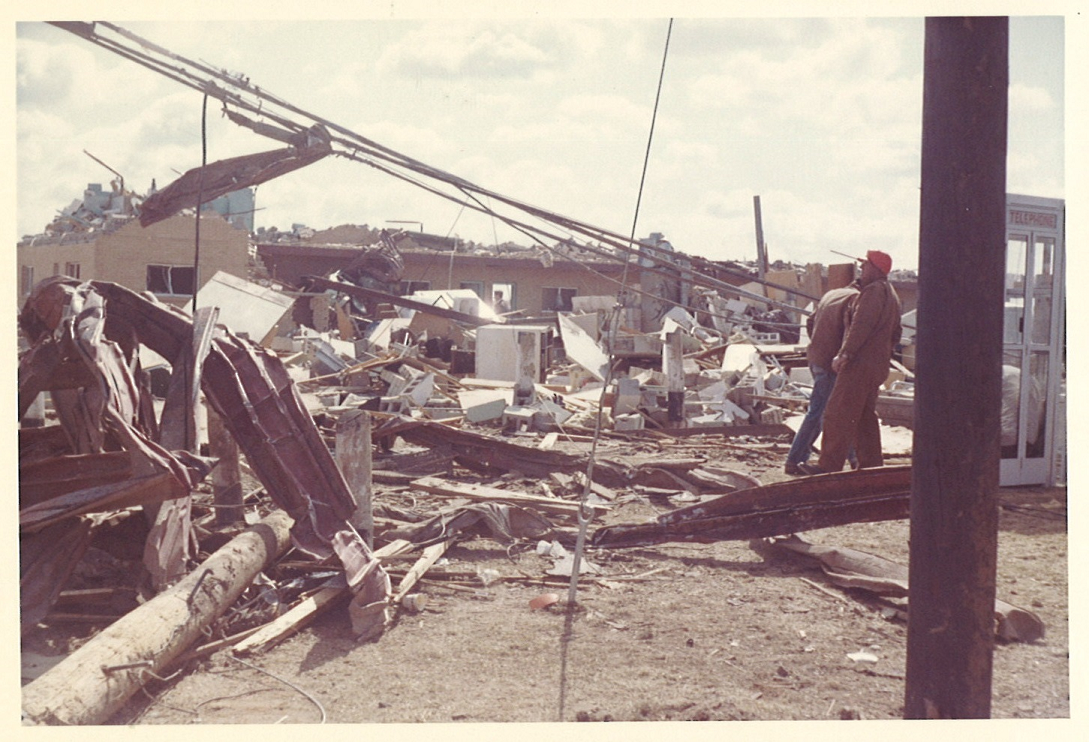
The Swan Inn after the tornado. Photo courtesy of Margaret Tanase.
Account of Sue Jager
It was Palm Sunday 1965. My husband Glenn and our three daughters, Brenda age 5 ½ years, Annette, age 3 years and Crystal age 1 ½, were enjoying a birthday party at my Mother’s home in Pierson, MI. It was a hot, sultry day with an unusual yellow cast present that never left. We started back to our home in Burnips, Michigan about mid-afternoon. We were south of Cedar Springs and just past a place known as Poppel Hill, which had a large car sale lot on the top of the hill, when a very strong wind and rain storm made it impossible to drive. We pulled into someone’s yard as we could not go any further. The wind was so strong my husband could not open the car door. We were frightened and knew this was not just an ordinary windstorm; we were in trouble!
Fearing for our children’s safety, we put our baby on the floor of the car and our other two daughters with our own bodies. The last thing I remember seeing before I bent over my children was a telephone pole snapping in two very near us. I thought “this is the end”. We could feel objects striking our car and blowing it back and forth. It seemed like forever but it was only a short time until it passed. Our girls were so frightened. We tried to calm them and then we looked out the window to a war zone. That’s just what it resembled. We saw a house not far away. We hurried to their door and they rushed us inside. There were other people inside already. We did not know if another storm would hit us again. We were surprised to find out it was a tornado. We never saw it coming nor did we see it go. We just knew it was getting very dark with a strong, loud wind and a very eerie color.
Since going down south was impossible on 131, it was decided to go back to my aunt’s house in Cedar Springs. They still had power and we heard the reports on TV of all that had happened. We had to be careful driving back north to Cedar Springs as wires, fallen trees and destruction was everywhere, The large car dealership on Poppel Hill that we had passed earlier was badly damaged. The roof of the dealership was lying on the ground and glass was blown from the windows. I think we were too stunned to fully realize what had just happened earlier to us and other people.
We heard on TV that a tornado had hit Burnips and a woman that lived in a mobile home was killed and her mobile home destroyed. My husband said we had to return immediately for fear it was his mother. We called the state police and they told us to travel down 131 because that would be cleared first, so that’s what we did. When we got about two miles from Burnips a man stopped us and said we couldn’t go any further. My husband asked “how bad is it?” The man told us that Burnips was “wiped right out, right off the map”. Our hearts sank for my husband’s entire family lived there and our home was there, but for now our deepest concern was for his family’s safety. The man informed us to go around the other way and we did.
We reached our home on 30th Street south of Burnips and saw no damage. What a relief! We made our way to his mother’s house. She was OK, no damage at all. The other family members also escaped damage. When we arrived at Burnips it was all secure. There was a lot of damage on 142nd street west of town, though. That’s where the lady in the mobile home was killed. Friends of ours had their barn damaged and many cows were killed. Their daughter had her Sunday dress hanging on a hanger on the closet door. She was about to get ready for church when the storm came and blew every window out of their house. Her dress was found in a tree quite a distance away but still on the hanger. Boards of buildings were driven into the ground and there were many objects hanging from trees. Months after the storm items were found far away that belonged to people in the path We are thankful and fortunate that our family survived but sorry for the victims of the Palm Sunday 1965 tornadoes. It’s certainly something that we will never forget.
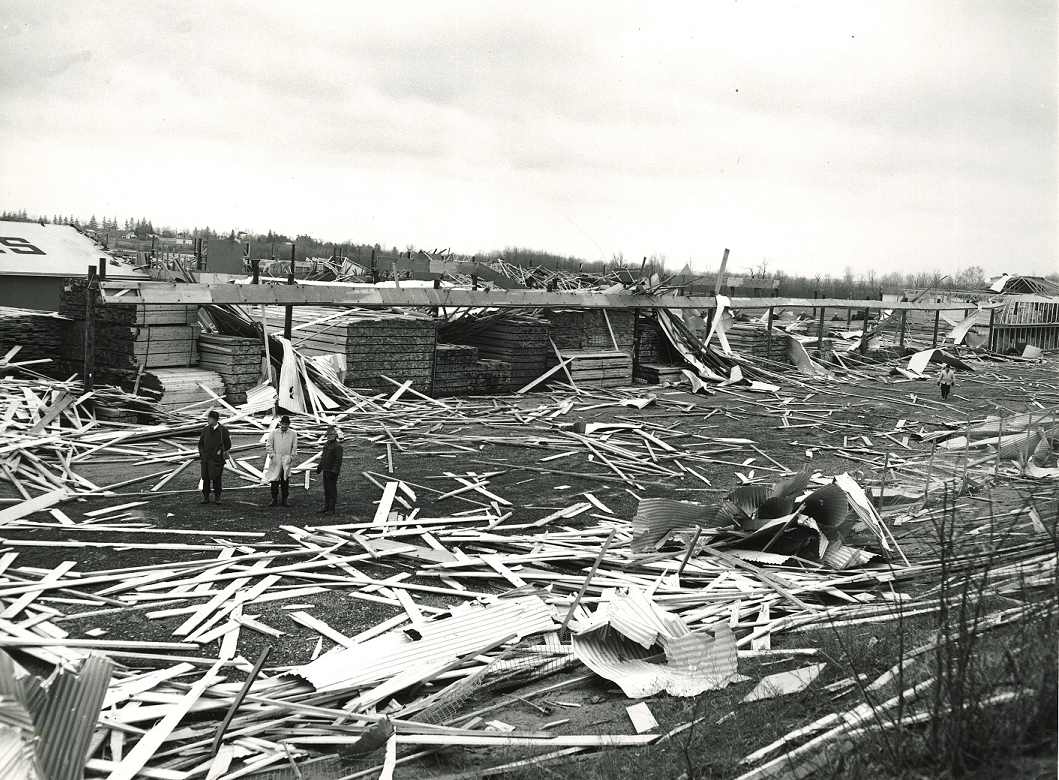
The Wickes Lumber yard after the tornado. Photo by William C. Wallace.
Account of Tom Millis
It was a warm afternoon that Sunday of April 11, 1965 and it was my 17th birthday, which I was celebrating with my friends and family at our house on Six Mile Road, just east of Alpine Avenue. I was walking with my girlfriend, Mary Lee Marlatt, around the back yard when family members shouted from the house to get to safety. It had gotten really dark and now we could see a huge black cloud coming towards us. I took Mary's hand and started walking only to be thrown against a wall of a new shed by the wind. We made it inside, but the shed was being twisted and started to move up on an angle. We dropped flat to the ground and held each other as the windows bowed and the lumber exploded. Mary was screaming as I prayed, "Lord, let me grab her". Together we were sucked up into the debris and my feet were just flopping. Our legs and arms were entwined as we were raised up and down three times, bouncing back up until the last time. With dirt, sand and shards of debris pelting my face, I couldn’t open my eyes. I was only able to squint from time to time to see parts of buildings, cars, yard equipment and such flying through the air. The dirt was like a sand blaster. A bowling ball hit me in the elbow and shattered the joint. It also hit Mary in the head. When we landed in the field behind my house, we were about 100 feet away from each other. At this point, there was dead silence. I was dazed and tried to stand and walk, but I kept falling, so then I crawled. My brother and sister came from the house, which had collapsed. They and others had lacerations and bruises, but were basically okay. I was taken to the hospital where I stayed for several weeks, healing a fractured leg and arm along with many cuts and scrapes from the pelting of dirt and debris. Later, I heard that Mary was found dead in the field. The medical examiner said she died of multiple skull fractures. We lived in a trailer on the site of our home while a new one was being built. For many years after the tornado, things like the smell the mud in the spring or the taste of potato salad would remind me of that day and the horrible memories would come back. To this day I will not celebrate my birthday if it falls on Palm Sunday.
Account from Sandee Millis Crinion
I remember that Palm Sunday as my brother Tom's 17th birthday. Family and friends came to our house on Six Mile Road for a spring dinner which included Mom's homemade potato salad and her mayonnaise cake. By late afternoon the folks went to Westgate Bowl and a few of us were just at home listening to the radio. Grandma (Pearl) Young lived with us and she was there in the living room in her chair.A warning came across the radio and my older brother, Jim, shouted to us, "Hit the floor". I remember seeing Tom and his girlfriend, Mary, out by the shed and the shed falling apart. Everything was swirling around us as we lay there. We were hit with grit and pieces of wood and stuff. I could only imagine that we were dying. It was hard to breathe and we all had pitted skin from the dirt and debris.When it was over there were people helping us out from under the rubble. Our house was totally destroyed. I remember seeing Grandma sitting in her chair, but she was covered with grit and it looked so unusual. My sister Linda was bleeding from her head and my other sister Sal had a head gash that was deep with a piece of wood stuck there.I remember seeing Tom out in back as he tried to come from the field to the house. I went out there and grabbed for his arm to help him, but it went limp. That was because his elbow was fractured. Tom, my sisters and Grandma went with a neighbor to drive the injured to the hospital. The car had half of the windows blown out, but it ran. I was there when medical personnel came for Mary. Her body was in the field. I didn't know if she was injured or dead. Sadly, she had died.My Uncle "Buster" (Lawrence Young) lived nearby and was there to check on us. With the other family members gone to the hospital, I asked if we could go to Westgate Bowl and find my folks. Uncle Buster worked for Bell Telephone, so he was able to get past the checkpoints along Alpine Avenue. When we got there, we found out that they had left. We then drove east to Division Avenue and back to Six Mile Road. We got as far as the railroad tracks and were blocked by downed trees. I told Uncle Buster that I could walk the rest of the way back home. I was 15 and felt I could do it, or maybe I was still in shock and only wanted to get back home.By now it was dark and chilly. A lady at Westgate had given me a coat, so I was a little better off from the cold. It was eerie to walk a familiar road that was now strange and messed up. I wondered if another tornado would come.I made it to the Noom's house and they had windows blown out, but most everything else was intact. Later, we found our dog Max hiding at this neighbor's house. He came back home two days later. My brother Jim, and I stayed overnight with neighbors. I was very restless all night and stayed close to Jim.The next day we went to Comstock Park and suddenly saw our folks coming out of the drug store. What a reunion! We all had tears of happiness. They had met people taking my brother and sisters with Grandma to the hospital. Our family went to stay with relatives for about a week and then two trailers were put on our property where we lived as our new house was being built. I am cautious when storms threaten, but I am not terrified as others are after such a life-changing event.
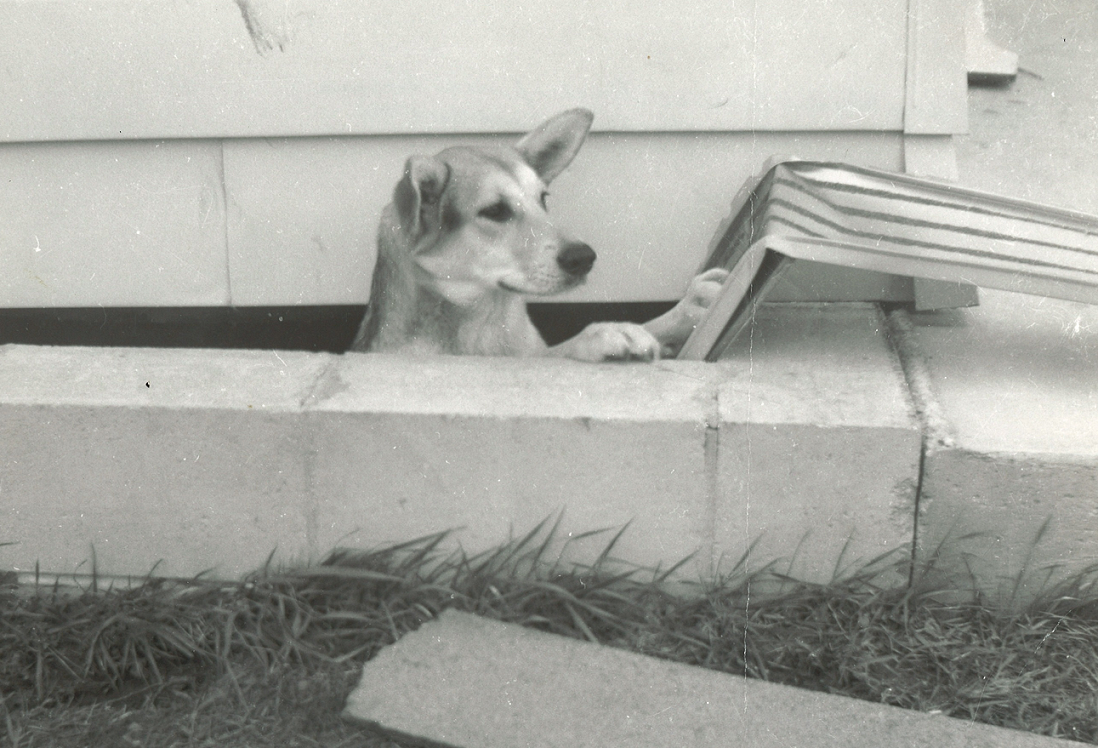
A family pet surveys the scene after the tornado. Photo courtesy of Janice DeFreyt
Account of Cathie Slaktoski Schaefer
I was 12 years old and remember that April 11th was a warm day and late in the afternoon the sky became a sick yellow and green color. My parents, Walter and Jane Slaktoski, had moved into a new home not far from the old one that was being rented on Pine Island Drive. Because of the weather conditions, my dad made us go to the basement, where we huddled under a table with pillows and quilts. When the storm passed, we went outside. We were okay and wanted to see what happened to the other house. National Guard troops were at highway corners to redirect traffic. My mom and dad pleaded to let them get to their property and the guard let them drive through. Electric poles were down and the wires were dancing around in the breeze. A neighbor's boat and camper were mangled and in a ditch. At our property, two huge oak trees had fallen across the road and were being cut up by the National Guard. I saw an ambulance drive away. Later, we found out a neighbor that lived north of us died, along with one of his daughters.No one was in the rental house at the time. It was severely damaged and the two-stall garage was demolished. We spent many days picking up debris. The house was remodeled and we lived there for 12 years. In 1977 my husband Tom and I used that same spot for a new home.In 1966, the freeway from Grand Rapids (US-131) was extended from Comstock Park. As it goes through the hills and valleys it almost parallels the 1965 Palm Sunday tornado path from Pine Island Drive and north toward Rockford. This was also the path of the 1956 tornado. The local people often called it "Tornado Alley".
Account of Don Bunning
It was a humid Palm Sunday when our family of three boys decided to take a trip to enjoy the first warm days of spring. As we were riding through the countryside we turned the radio on only to learn that Comstock Park was having a tornado. We found that very hard to believe because south of Grand Rapids where we were, the sky was only partly cloudy. Upon returning home I decided to check to see if there any damage to Stony Creek School where I was the principal. Stony Creek School serviced the Westgate addition to Comstock Park, where the tornado had struck. I was amazed to see the devastation as I approached Westgate. Roads were blocked with fallen trees and debris. Some homes were leveled and others were missing top stories or twisted off their foundations. Many were without roofs and some had lost sections of their homes leaving furniture and appliances standing in the open, appearing untouched. There was no power throughout the area. I needed identification to pass the security checkpoints that were already in place, and when I got to the school the Red Cross was ready to set up a disaster center in the Stony Creek building. I stayed into the evening, helping to set up the center. No families used the center for overnight lodging since most of them had families or friends in the area. When I returned to school on Monday I was recruited to be a contact person so the residents of Westgate could communicate with friends and family in other states affected by the tornadoes.They appointed me because I knew the area and many of the families who had children in the Stony Creek School. The Red Cross issued me credentials to travel throughout the tornado area without any restrictions. Workers and tornado victims were provided food and shelter at the Comstock Park High School. The disaster plan was in effect the entire week of Spring Break. School opened as scheduled on April 19, 1965. The roads had been cleared and the community was restored to its pre-tornado state.
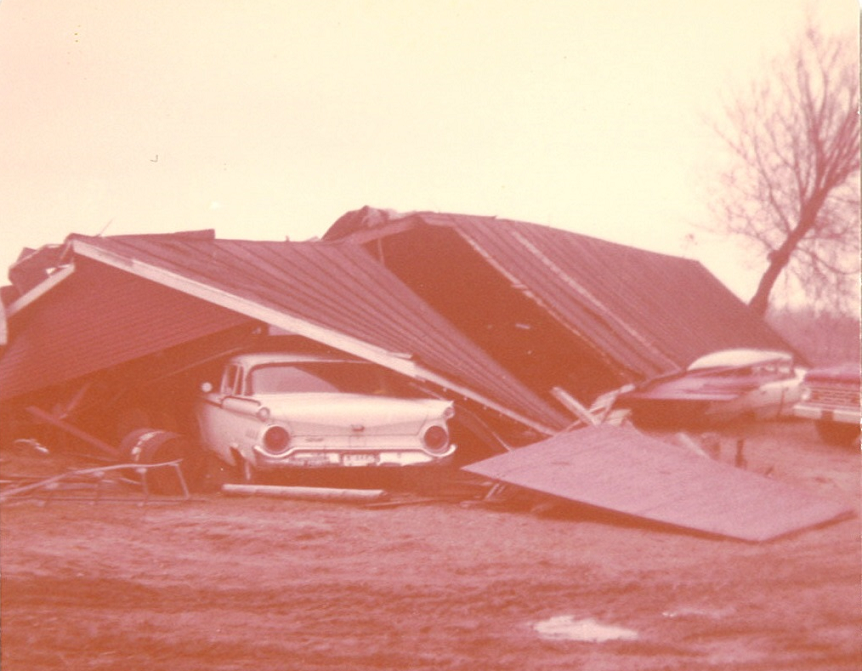
Damage south of Marne, Michigan. Photo courtesy of Steve Carlson.
Account of Kathleen Proulx
The weather was hot and muggy that Sunday. My family decided to take a short drive to Little Pine Island Lake to visit my Aunt Rosemary and Uncle John Milanowski at their cottage. As we were out enjoying the day the sky got darker and the wind came up. We heard the sirens or someone gave us a notice that storms were coming. There was no basement at the cottage so we ran south to the Ketchel's house. They had a swimming beach and pavilion and they also had a basement. As we ran the sky darkened and there were clouds that looked like tornadoes. I remember my parents saying “keep running!” We got to the Ketchel’s basement and I remember saying the Rosary there. After the storm had passed we drove home on Alpine Avenue, and we saw a lot of debris scattered around.My cousin, Father Paul Milanowski, was an associate at Holy Trinity Church, which had been hit by the tornado and sustained quite a bit of damage. Account of Dick Besser I was a young Grand Rapids Police officer working Car 3 with my partner Don Phillips that day. We were on the corner of Bridge Street and Stocking Avenue, when we noticed an ominous quiet. The sky and even the air around us were a sickly yellow-green color. There had been no warning of tornadoes, but I had witnessed them in the past, so we watched the sky and headed west. As we approached Standale we saw the funnel dip out of the clouds. We called in on the radio that there was a twister north of Standale. There still had been no warning of a tornado and our radio call was the first warning of this event. We turned on the overheads and drove rapidly toward the twister, using the Public Announcement system to warn people to take cover. We headed north on Wilson Avenue and started to see damage north of Richmond Street. It got worse near Three Mile Road. We ran to the wreckage of a house on Wilson but found everyone OK, so we began to go east on Three Mile. It was very dark and raining but we could still see the funnel north of Interstate 96 heading northeast. We were giving a blow-by-blow description over our two-way radio to the dispatcher, asking them to send aid to the area we were leaving. We discussed that we were in a good position to track the twister so that warnings could be given out. We drove onto Interstate 96 and headed east towards Alpine Avenue. As we went north on Alpine, another Grand Rapids Police car, X-1 manned by John Morris, fell in behind us. We were unaware as we approached Alpine Church Road that we had gotten ahead of the funnel. It was dark and raining hard. There was a car ahead of us and a semi coming south toward us. Suddenly it got very dark and the rain became torrential. Our car began to rock violently. Phillips managed to stop as we were pushed onto the shoulder of the road.The tornado had crossed Alpine directly in front of us. We never saw it coming.In a few moments, it became clearer and we saw the semi on its side and the car ahead had been blown into the field to our east. The driver was deceased. We went to the Swann Inn and other buildings nearby to look for and help victims. I was very worried that the survivors may be injured or killed by the live electrical wires that were strewn around. Because ambulances had not arrived, Morris and I began to shuttle the injured to Butterworth Hospital while Phillips did what he could in the Alpine Avenue and Six Mile Road area. After a couple trips we began to organize groups of men to look for and assist victims as ambulances and other rescue people began to arrive. I recall that our group tore apart the remains of a house on Six Mile Road, east of Alpine Avenue, with our bare hands. Neighbors believed a young girl was trapped inside. Thankfully, she had been visiting friends. I remain amazed by what a group of men could do under the influence of adrenaline. The devastation was awesome. I saw cable that stabilized large power poles, made up of several strands of steel, each about half the diameter of a pencil, completely unraveled, about 10 to 15 feet of it! The ground was stripped of vegetation, trees were shredded and the stark wreckage of homes and cars were everywhere. About this time we heard that a man and his daughter had been found deceased. I remember thinking how sad that was and how the man had bravely tried to shield his daughter. There was a good deal more sadness as other people were found who did not survive. Within a couple hours a command center had been set up to coordinate efforts. The Grand Rapids Police Department had an old house trailer that we had converted for this purpose. Area police joined with firemen as well as other volunteer organizations.The injured and homeless began to be seen in a more orderly fashion. I was struck by how effective the efforts of ordinary citizens and the few police and fire personnel had been sorting things out – searching, rescuing, transporting, etc. – before things became more organized. In the face of tragedy we laid down our differences and pulled together. I salute that spirit.

Ida May Bolt and her daughter Esther, along with “Boots” stand in front of their home on Six Mile Road in Comstock Park. Photo courtesy of Cathy Greenwald.
Account of David A. Barringer
In April of 1965 I was nine years old. Coming from a large extended family it was not unusual for many of the family members to gather together near important holidays to celebrate those events. Such was the case on April 11th. Our family had chosen to celebrate Easter early (to free up Easter Sunday for other family activities) by gathering at my aunt's home/cottage which was located on N. Pearl Beach on the eastern edge of Coldwater Lake in Branch County, Michigan (Lat: 41 deg; 49 min 35.7 seconds N Long: -84 deg; 59 min 5.38 sec W).
My aunt's cottage was located directly on the lake shore probably no more than 100ft from the water's edge. It was a typical two story home of framed wall construction that had an enclosed porch facing the water that had six large bay windows (probably 6ftX6ft.) that made that porch essentially a sun room. With windows facing N, E, and S it also offered great visibility on a clear day.
As per usual our family spent most of the day at the lake and I can clearly remember the weather being unusually warm for that time of year. Not only was it warm, but it was very humid with a fog like mist hanging in and around the properties at the lake's edge. As I remember, the visibility was not very good, maybe up to two hundred yards at best. There was little wind and the lake's surface was very calm. Later in the day a light rain began to fall limiting outside playtime with my cousins near the cottage. A few homes to the north were some teens that were wading in the water as the day came to an end.
Since being stuck inside was not much fun with all the adults around, my cousin and I decided to watch TV. We had just started to watch Lassie (CBS 7-7:30) when the power went out for no apparent reason. I distinctly remember looking up and out of a north facing nearby window just after the power went off and noticed that the sky had taken on an unusual color; something like a muted grayish-green and not knowing any better thought nothing of it. Around that time some of my aunts were scurrying around the house trying to find candles or lanterns to give some light to the darkening interior and I remember one of my uncles making note of an unusual darkness in the sky (to the south I assume) and asking the others at the card table if what he was seeing was a swarm of bees or something. Another uncle, in a more panicked voice shouted that it wasn't bees but a tornado headed our way. Immediately after that my uncles began to scramble toward the inner portion of the house while all the time yelling for everyone to get down on the floor. No sooner than they said that the tornado hit and all I can remember is the sound of glass crashing all around me seemingly coming from every direction.
During those few moments all I can remember hearing were a lot of screams and cries of panic from others in the house. Being afraid and unsure what was happening I began to look around for one of my parents who were nowhere in sight. Luckily for me a family friend, who was also a volunteer fireman, grabbed both my cousin and I while we were on the ground and covered us up with his body while the storm raged on and finally ended. I never knew who that guy was but nor did I ever meet him again but his actions likely saved both me and my cousin from some pretty serious injuries and or death.
Immediately after the 1st storm's departure family and friends inside the house slowly started getting up and assessing for injuries and or further dangers. In my case I had somehow lost my shoes and was attempting to walk thru the house thru heaps of broken glass (from the many windows in the house) had littered the floor trying to find my parents. While wandering aimlessly through the house I saw my Aunt lying on the floor in the kitchen with a sizeable gash on her forehead with blood flowing freely from the cut. Although she was barely conscious she had no problem swearing out loud about a damn tea kettle that had flown across the room and hit her in the head. It was truly a brief moment of levity in a situation that was frightful to say the least. After a lot of discussion by others in the house it was determined that her cut and probable concussive injury were significant enough to warrant getting her to the local hospital (about 15 miles away in Coldwater) immediately. To that end my uncle (her husband) and the fireman friend (mentioned earlier) were able to locate a vehicle that was not badly damaged and work it free from the debris field that surrounded the area. They loaded up my aunt along with a couple of other injured relatives into the car and attempted to negotiate their way thru the downed trees and debris toward Coldwater. For the rest of us, and for the remainder of that evening we never knew if they completed their journey or if my Aunt would survive her injuries.
In the meantime the rest of the adults were assessing the damage to the cottage and it was determined that it was too dangerous to stay inside there for fear of a fire or structural collapse so we all made our way out to my uncle's detached garage that miraculously had incurred little damage from the storm. As I walked the 50 feet or so to the garage I remember looking back at the house and noticing that it had somehow been lifted and turned away from its foundation at about 10 or 15 degrees yet somehow managed to remain upright but badly damaged. Most of the residents in the area at that time had external propane tanks on their property and there was much concern and discussion about the potential for an impending fire or explosion. Not long after relocating to the garage and since complete darkness was coming on fast several of my male relatives went out on a mission to secure (shut-off) as many propane tanks as they could and to search for survivors and or anyone who could help us. While they were gone the rest of the family hunkered down inside the garage as best we could and tried to make ourselves comfortable while we waited for help. My uncle's car was in the garage so my cousin and I took up occupancy there along with my mother and another adult.
At this point everyone was pretty much shell shocked and in a state of disbelief and to make matters worse most of us had no idea what had happened or why. All we knew was that we were afraid, cold, wet, and shaking. Not too long after the men left the garage, maybe 10 or 15 minutes later all of them ran back into the garage yelling for everyone to get down and take cover because another tornado was heading our way. Within seconds the second tornado of the night hit and it seemed much more powerful than the first. First of all, and from my vantage point from the front seat of the car all I could see was the entire garage get swept away while the air was filling with debris. My mom, who was also in the car, forced my head down while she covered me up with her body. At that point I could feel the car start to turn and twist and go airborne for what seemed like an eternity but in actuality was probably only a few seconds. My mom was screaming (I found out late that the front passenger side car door had been slammed onto her leg breaking her ankle in a couple of locations) and I suppose I was too because I was certain that we were flying thru the sky to some unknown destination and fate. And then, as quickly as it began, it stopped. No more wind, no more noises of debris hitting the car, and no more rain. It was dead still and very, very scary. After a few minutes I could hear my dad uncles moving around when all of the sudden the car shuddered up and then down. We found out later that the car had indeed been picked up and the driver side rear wheel had come to rest on my uncle's shoulder dislocating it and fracturing his humerus. For a short while after that we (my cousin and I) waited in the car while the adults tried to pull together their frantic thoughts and decide what to do. At that point it became a unanimous decision that we had to leave the area before any fires broke or any propane tanks erupted. Many power lines were down and one of them was snapping and sparking as it lay across the road near the spot where the garage had been located. The men quickly splinted my mother's leg and helped her walk while the remaining seven or eight of us took off walking toward the main road that led west away from Pearl Beach. Since the road was blocked by downed trees, power lines, and indescribable amounts of debris it was decided that we would walk southwesterly across an open farm field toward the main road west and away from the damaged area. At this time it was fully dark with nothing to light our way and walking thru the debris and the field became a treacherous trek.
At that time all of my relatives smoked so they were all taking turns lighting lighters and matches to give even a little bit of light, which wasn't much. Eventually and very slowly we made our way out of the area where cottages were located and entered the field which became its own kind of hell for us to encounter. The entire field was filled with scattered debris which contained parts of homes, cars, timber and sheet metal that formed anobstacle course that was extremely difficult to maneuver through. We also came across several head of cattle that had been impaled or otherwise hit with debris and were now suffering in agony. We even came across a dead body that our parents directed us away from so that we youngsters would not see it. For most of us that journey past the damaged homes and across the open field may have been more upsetting than both of the storms combined.
Off in the distance, perhaps a mile or so away, we could see the emergency lights of rescue, fire, and police personnel as they tried to make their way down the debris blocked Copeland road. During our trek across the field we encountered several more survivors from the beach area, some of which were hurt pretty badly, and we collectively made our way toward the rescue personnel. We all tried to help each other out as best we could but the shock of the storm, injuries, fear, and pain were quite overwhelming and many of us were near our breaking point. As we moved further away from the beach area there was less debris and the going got easier. Eventually we reached the emergency personnel and they began ferrying us all in to the city after triaging who needed help the most. My mom, with her broken ankle, was one of the first to head out in an ambulance while my dad and I watched patiently. Eventually we were also taken to the Branch County Hospital where we joined the many dozens of others who had been injured during the historic tornado breakout of April 11th, 1965.
The Aftermath
After a few days of recovery and after the National Guard had secured the area from looters we were finally allowed to re-enter the damaged areas to begin the cleanup and the recovery of family valuables. What I saw the day we returned was devastating to me.
My aunt's cottage, or what was left of it as I remembered while exiting it on my way to the safety of the garage that night was reduced to a pile of rubble strewn across several of the neighbors yards and much of it ending up in the shallows of the lake itself. The fact that the house was somehow turned or twisted during the first tornado became somewhat of a local mystery to the survivors. How a home could be severed from its concrete foundation and moved virtually intact and not much damage was always a puzzle waiting to be solved. That puzzle, however was fully destroyed after the second tornado moved thru the area.
Three or four of the adjoining properties had total devastation as well. Immediately to the north, next to my aunt's house, was a home that attended to the needs of three or four elderly men two of which were found dead in the rubble near the home. Both owners survived but one was severely injured and never did fully recover from his injuries. Ironically enough, he was blown from his house during the second tornado and was slammed into the propane tank that serviced his home - the very same tank my family members tried to secure shortly after the first tornado passed. Since he was unconscious and buried beneath a pile of debris he was not found for about a day and many had feared him dead and perhaps blown into the lake. It was quite a story of survival for all of us to dwell upon.
The garage where we all took shelter after the first tornado passed was gone, completely. Zip, zilch, nada, none! There was nothing of it to be found; not a single scrap of debris was ever located or identified as belonging to that building. Since there was a small swampy area just to the west of the beach it was always assumed that the debris from the garage ended up there but nothing like that was ever confirmed.
The car that myself, my mom, and my cousin took refuge in before and during the second tornado had indeed been picked up and moved about 20 feet and turned about 75 degrees to the NE. My uncle who was lying next to the front of the car when the second tornado hit the garage said he saw the car go airborne and was himself blown along the same path before it was more or less dropped on his shoulder. The sudden up and down shudder we all felt afterward the tornado had departed was the effect of my dad and another uncle lifting up the rear of the car by hand while another pulled him clear of the wheel. Amazing what adrenalin can do in an emergency.
Another odd story that surfaced about that car was that none of the windows were broken out except for one during the passage of the second tornado. That window, the driver sider rear had been pierced by a very long length of 2 X 4 lumber and had come to a rest exactly where my cousin had been laying covered up with a heavy blanket. The incoming end of the lumber had been snapped off and had a very sharp point which could have easily impaled my cousin had he not be covered with the blanket.
Account of Doug Houseman
My father was a state police officer stationed in White Pigeon during the tornadoes. I ended up riding with him (I was in fifth grade) when he was detailed to drive to Shipshewana, Indiana right after dawn on April 12th. I remember seeing a barn that was thrown in the swamp - with the live cows standing in the stanchions where the barn had been and a car wrapped around a tree 25 feet in the air - and the passenger compartment less than a foot across and the rear bumper of the car 90 degrees or so from the front bumper.
But the real memory was the road that had been blacktopped on April 9th. More than a half mile of the black top was rolled up like a huge jelly roll. I don't know how many of the pictures from that area survive, but the library in White Pigeon got copies of all the pictures my father took that day on the trip down and back. It took several hours to go down and back, stopping to check on people as we went. Other officers were responsible for checking the rest of the area along US-12 and other roads in the area. When we got home, I found a broom and a Raggedy Ann type doll on the roof of our house, and several full boxes of food in our back yard. I never did find out where they came from, but it had to have been several miles away.
A couple of weeks later I watched my first Amish barn raising at the site of the cows. That was as impressive to me as the damage the storm did.
Account of Sandy Haner
I remember the tornado of 1965 very well. My mom had just gone to work at Westgate Bowling alley. My dad was feeding us dinner at the time and he happened to be looking out our front door in Comstock Park. Suddenly, he yelled for us to get in the basement. When we were in the basement, I remember seeing our flowering crabapple tree get bent all the way to the ground. My dad thought that it would be dead, but amazingly it survived. My mom was helping people at the bowling alley that needed medical care from the tornado. After it was all over, and my mom was safely home the next day, we went for a ride to see all the devastation. Trees were down everywhere. The Swan Inn's sign got all twisted, too.
What if?
Preparing for the Next Big Tornado Outbreak
What if a storm like this were to happen today in West Michigan? Are we prepared? Although the awareness to the threat of severe weather and the presence of early warning systems are much improved since 1965, this is at least partially offset by the increase in population density. Many areas that were open farmland or woods have been converted to residential areas and commercial districts. The increase in population makes it even more important to get the best use out of modern technology to minimize the threat posed by severe weather, and specifically, by strong tornadoes. Although they are relatively rare in Michigan, strong tornadoes like those of April 11, 1965 will occur. The best way to be prepared is to know how to get the warnings and what to do when the warning is issued. Have a NOAA Weather Radio ( https://www.weather.gov/nwr/) with a tone alert feature. Have a plan that includes the safest place in your home to go to when a tornado warning is issued and practice the plan. Also know the safety rules to follow if you are caught outside or in your car when a tornado is approaching. Refer to the National Weather Service severe weather safety brochure at http://www.nws.noaa.gov/om/brochures/ttl.pdf. Taking time to learn this information can save your life.
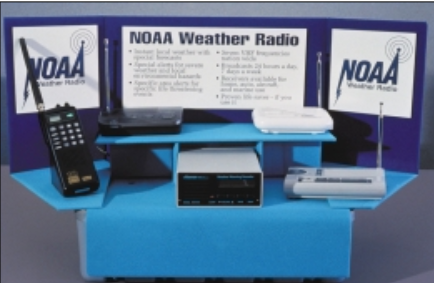
Safety Tips for Tornadoes
Courtesy NOAA/National Weather Service
It should be pointed out that there are no absolutes in terms of safety from tornadoes. While each situation is unique and in some cases even being in a basement under a sturdy table will not be completely safe, following these rules will generally increase your chances of avoiding death or serious injury.
Before the storm: Identify the safest place to seek shelter in your home, work place, or buildings that you visit frequently. Ideally this place should be below ground. Otherwise it should be on the lowest floor in an interior room, such as an interior closet or bathroom. You want to put as many walls between you and the outside as possible. You also want to avoid being under large roof areas such as department stores, auditoriums or gymnasiums, as the roofs are more likely to collapse. If you live in a mobile home, have a place to evacuate to, such as a nearby sturdy building, or ditch or culvert that would afford protection from flying debris.
At least once a year, preferably in late winter or early spring, practice your tornado plan. Have your family evacuate to the safe place. Keep a flashlight with fresh batteries and some bottled water on hand. Have a predetermined place for your family to meet after a disaster.
Be aware of weather conditions. If severe weather is expected, have a means to monitor weather reports such as a television or radio. Battery operated NOAA weather radios are ideal to take along if you are traveling or planning to be outdoors and away from television. Know the warning signs of an approaching tornado. Watch for a sudden calm or wind shift after a fall of heavy rain or hail and scan the horizon for the blue-green flashes of light near the ground that indicate power lines being blown apart. Listen for a roaring sound, like persistent thunder that does not fade. Look for the funnel cloud or swirling dust or debris near the ground along with a lowering cloud base. Strong tornadoes will often pick up debris and loft it high into the air. What looks like a swarm of birds or swirling leaves, but are actually much larger pieces of building material or tree limbs, will sometimes announce the arrival of the tornado before the funnel can be identified.
During the storm: If at home or work, head for your designated safety area and remain there until the storm is over. Don’t waste time closing windows. If you are in a sturdy building, go to the lowest floor and seek shelter in an interior room or hallway. Avoid windows and the large unsupported roofs found in auditoriums, gymnasiums and shopping centers. If you are in a vehicle, it is only safe to try to drive away from the tornado if it is visible from far away and traffic is light. Otherwise, the safest approach is to pull off the road and to follow the safety rules for those in mobile homes and those caught outdoors: seek shelter in a sturdy building. If none is available, find a ditch or culvert. Get as far away from trees and cars as possible and lay face-down on the ground, covering the back of your head with your hands.
After the storm: Downed, live power lines, gas leaks, broken glass and nails are some of the hazards to avoid. If the building has been badly damaged, evacuate from it. Avoid going near heavy walls or parts of ceilings that could collapse. Wait with your family for emergency personnel to arrive. Carefully tend to those who are injured. Avoid puddles with wires in them; they may still be carrying electricity. Use flashlights instead of matches or lighters. Remain calm and alert, and listen for information and instructions from emergency crews or local officials.